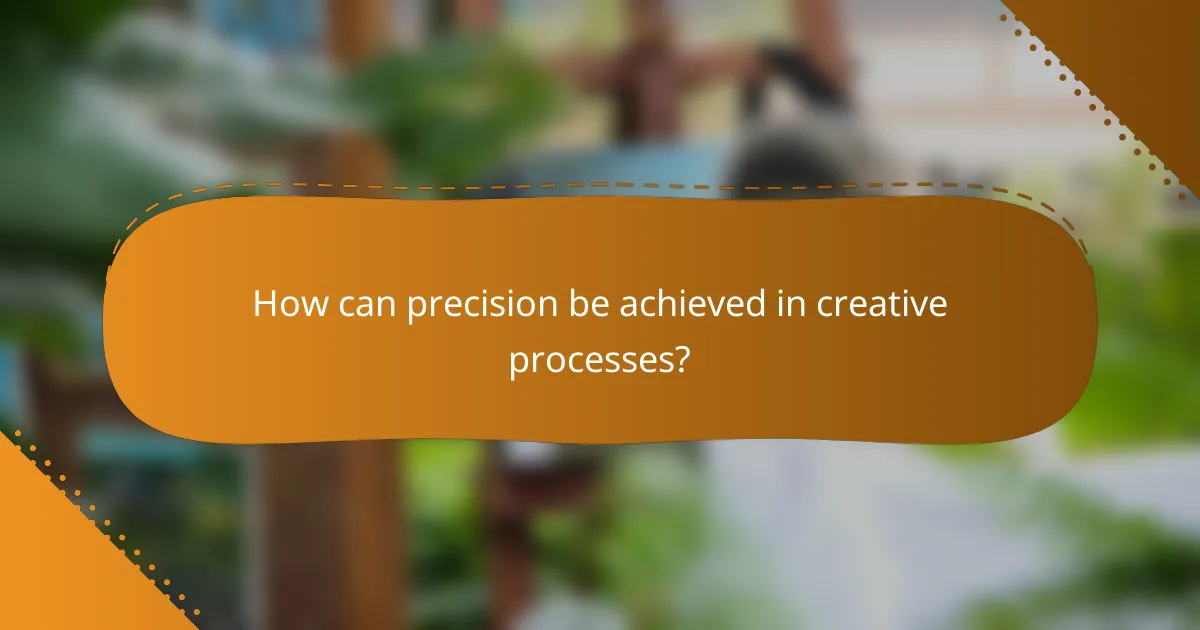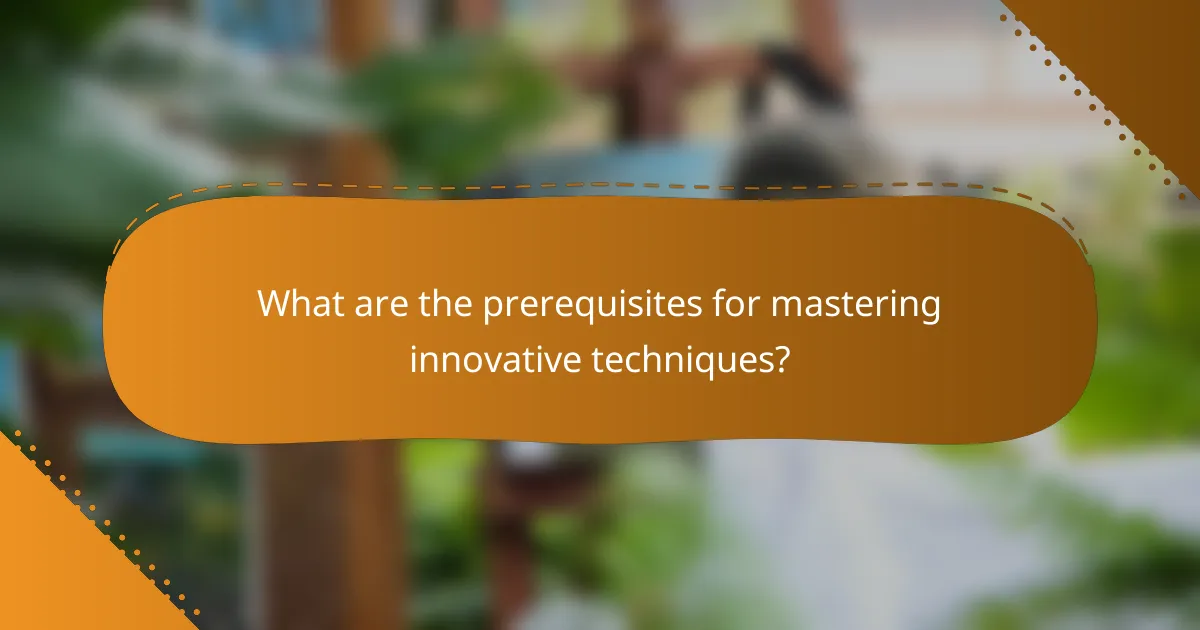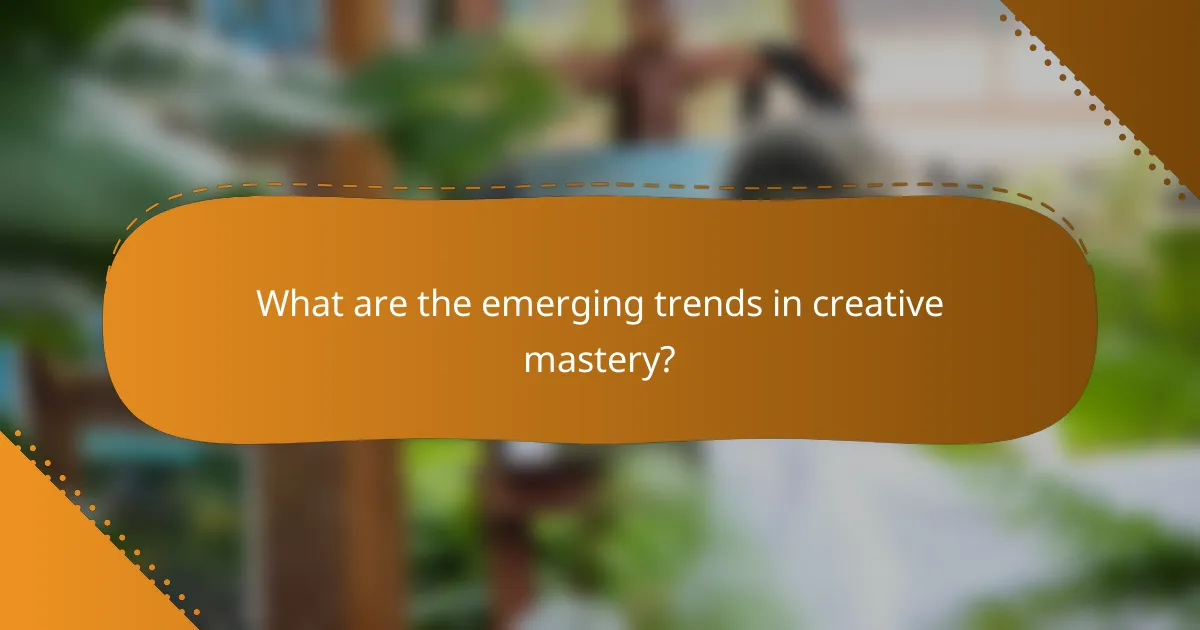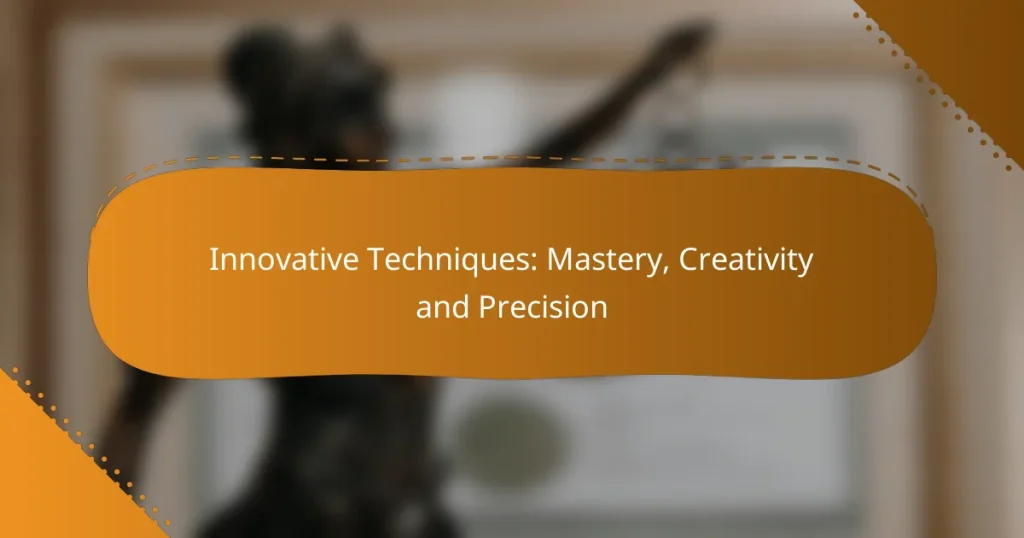Innovative techniques play a crucial role in enhancing mastery, creativity, and precision across various creative fields. By employing methods such as mind mapping and iterative prototyping, individuals can refine their skills and foster continuous improvement. Additionally, the integration of technology and structured methodologies allows creators to achieve greater accuracy while preserving their artistic vision.

What innovative techniques enhance mastery in creative fields?
Innovative techniques such as mind mapping, iterative prototyping, collaborative workshops, and feedback loops significantly enhance mastery in creative fields. These methods foster creativity, refine skills, and promote continuous improvement, enabling individuals to achieve higher levels of expertise.
Mind mapping for idea generation
Mind mapping is a visual tool that helps in organizing thoughts and generating ideas. By creating a diagram that connects concepts, individuals can explore relationships and expand their creative thinking. This technique is particularly useful in brainstorming sessions, allowing for a free flow of ideas without the constraints of linear thinking.
To implement mind mapping effectively, start with a central theme and branch out with related ideas. Use colors and images to enhance memory retention and engagement. Aim for clarity and simplicity to avoid overwhelming complexity.
Iterative prototyping for skill refinement
Iterative prototyping involves creating multiple versions of a project, allowing for gradual improvements based on feedback and testing. This technique is essential in fields like design and software development, where refining a concept through cycles leads to better outcomes. Each iteration should focus on specific aspects, such as functionality or aesthetics, to enhance overall quality.
When using iterative prototyping, set clear goals for each version and gather input from peers or users. This process not only hones technical skills but also cultivates adaptability and problem-solving abilities. Keep iterations manageable, focusing on key changes rather than overhauling the entire project each time.
Collaborative workshops for creative synergy
Collaborative workshops bring together individuals from diverse backgrounds to foster creative synergy. These sessions encourage the sharing of ideas, skills, and perspectives, leading to innovative solutions that may not emerge in isolation. The dynamic environment of a workshop stimulates collaboration and enhances the creative process.
To maximize the benefits of collaborative workshops, establish clear objectives and create a structured agenda. Encourage open communication and respect for all contributions. Consider using techniques like brainstorming or role-playing to stimulate engagement and creativity among participants.
Feedback loops for continuous improvement
Feedback loops are essential for continuous improvement in any creative endeavor. By regularly seeking and incorporating feedback, individuals can identify areas for enhancement and refine their work. This process fosters a growth mindset, encouraging creators to view criticism as a valuable tool for development.
Implement feedback loops by scheduling regular check-ins with peers or mentors. Use structured formats, such as surveys or one-on-one discussions, to gather insights. Be open to constructive criticism and actively apply suggestions to your work, ensuring that each iteration reflects growth and learning.

How can precision be achieved in creative processes?
Precision in creative processes can be achieved through the integration of technology, structured methodologies, and informed decision-making. By leveraging digital tools, standardized workflows, and data analysis, creators can enhance accuracy while maintaining their artistic vision.
Use of digital tools for accuracy
Digital tools play a crucial role in achieving precision in creative tasks. Software applications like Adobe Creative Suite or AutoCAD allow for meticulous adjustments and fine-tuning, ensuring that every detail aligns with the intended design. Utilizing features such as grids, guides, and measurement tools can significantly enhance the accuracy of a project.
Moreover, employing project management tools like Trello or Asana can help track progress and maintain focus on specific tasks, reducing the risk of errors. Regularly updating and backing up digital files also safeguards against data loss, which can compromise precision.
Standardized workflows for consistency
Implementing standardized workflows is essential for maintaining consistency across creative projects. By establishing clear processes and protocols, teams can ensure that everyone follows the same steps, which minimizes variability in output. For instance, using templates for design projects can streamline the initial phases and provide a uniform starting point.
Additionally, regular training sessions can reinforce these workflows, helping team members stay aligned with best practices. Documenting these processes in a shared resource can serve as a reference, making it easier for new members to integrate smoothly into the team.
Data-driven decision making in design
Data-driven decision making enhances precision by relying on empirical evidence rather than intuition alone. Analyzing user feedback, engagement metrics, and market trends allows designers to make informed choices that align with audience preferences. Tools like Google Analytics can provide insights into user behavior, guiding design adjustments that improve overall effectiveness.
When making design decisions, consider A/B testing to compare different versions of a project. This method allows for direct measurement of performance, ensuring that the final output is not only creative but also resonates well with the target audience. Regularly reviewing data can help identify patterns and inform future projects, leading to continuous improvement in precision and creativity.

What role does technology play in enhancing creativity?
Technology significantly enhances creativity by providing innovative tools and platforms that streamline the creative process. These advancements enable artists, designers, and creators to explore new ideas, collaborate effectively, and produce high-quality work with greater efficiency.
AI-assisted design tools like Adobe Sensei
AI-assisted design tools, such as Adobe Sensei, leverage machine learning to automate repetitive tasks and provide intelligent suggestions. This allows creators to focus on the conceptual aspects of their work rather than getting bogged down in technical details.
For instance, Adobe Sensei can analyze design patterns and recommend color schemes or layouts that resonate with target audiences. By using these tools, designers can enhance their creativity while maintaining precision in their projects.
Virtual reality for immersive experiences
Virtual reality (VR) technology offers immersive experiences that can inspire creativity by allowing users to visualize concepts in a three-dimensional space. This technology is particularly beneficial in fields like architecture and product design, where spatial awareness is crucial.
For example, architects can use VR to walk through their designs before they are built, enabling them to make adjustments based on real-time feedback. This hands-on approach fosters innovation and helps creators think outside traditional boundaries.
Cloud collaboration platforms like Miro
Cloud collaboration platforms, such as Miro, facilitate teamwork by allowing multiple users to brainstorm and share ideas in real-time, regardless of their physical location. These platforms support various formats, including diagrams, notes, and images, making it easy to visualize concepts collectively.
Using Miro, teams can organize their thoughts and streamline the creative process, ensuring that everyone contributes effectively. This collaborative environment can lead to more diverse ideas and ultimately enhance the overall quality of the creative output.

What are the prerequisites for mastering innovative techniques?
To master innovative techniques, one must build a strong foundation in creativity and gain access to modern tools and resources. These elements are essential for fostering an environment where innovative ideas can flourish and be effectively implemented.
Understanding foundational principles of creativity
Mastering innovative techniques starts with grasping the foundational principles of creativity. This includes understanding how to think divergently, allowing for multiple solutions to a problem, and convergently, focusing on refining those ideas into practical applications.
Consider engaging in brainstorming sessions or creative exercises that challenge conventional thinking. Techniques such as mind mapping or the SCAMPER method can help in generating and organizing ideas effectively.
Access to modern tools and resources
Having access to modern tools and resources is crucial for executing innovative techniques. This may include software for design, collaboration platforms, or even hardware like 3D printers, depending on the field of innovation.
Evaluate the tools that best fit your needs. For instance, graphic design software like Adobe Creative Suite or collaborative tools like Slack can enhance creativity and streamline the innovation process. Regularly update your toolkit to stay aligned with industry standards and trends.

How do successful creatives implement innovative techniques?
Successful creatives implement innovative techniques by blending mastery, creativity, and precision to produce unique outcomes. They often experiment with new methods, tools, and perspectives while staying aligned with their core vision and audience needs.
Case studies of leading brands like Nike
Nike exemplifies innovative techniques through its use of data analytics and consumer feedback to drive product development. By leveraging insights from social media and sales data, Nike tailors its offerings to meet evolving consumer preferences, resulting in highly successful product launches.
Another notable example is Nike’s “Just Do It” campaign, which combines emotional storytelling with cutting-edge digital marketing. This approach not only enhances brand loyalty but also engages a diverse audience, showcasing the power of creativity in branding.
Interviews with industry experts
Industry experts emphasize the importance of a growth mindset in implementing innovative techniques. They suggest that creatives should embrace failure as a learning opportunity, which can lead to breakthroughs in their work.
Experts also recommend collaborating across disciplines to spark creativity. By bringing together individuals with different skill sets and perspectives, teams can generate fresh ideas and solutions that might not emerge in isolation.

What are the emerging trends in creative mastery?
Emerging trends in creative mastery focus on integrating advanced technologies and sustainable practices to enhance artistic expression. These trends emphasize the importance of innovation while maintaining a commitment to environmental responsibility.
Integration of augmented reality in design
Augmented reality (AR) is transforming design by allowing creators to blend digital elements with the physical world. This technology enables designers to visualize concepts in real-time, enhancing client presentations and user experiences.
For instance, interior designers can use AR applications to show clients how furniture will look in their space before making purchases. This not only improves decision-making but also reduces the likelihood of returns, saving time and resources.
When implementing AR, consider the user interface and accessibility. Ensure that the technology is easy to use and does not overwhelm the audience with information. A well-designed AR experience can significantly elevate a project’s impact.
Focus on sustainability in creative practices
Sustainability in creative practices involves using eco-friendly materials and processes to minimize environmental impact. Designers are increasingly prioritizing sustainable sourcing, waste reduction, and energy-efficient methods in their work.
For example, graphic designers might choose recycled paper and vegetable-based inks, while fashion designers could explore biodegradable fabrics. These choices not only appeal to environmentally conscious consumers but also align with global sustainability goals.
To adopt sustainable practices, start by assessing your current materials and processes. Identify areas for improvement, such as reducing waste or selecting suppliers with sustainable certifications. Engaging in sustainability can enhance your brand’s reputation and attract a broader audience.

How can one stay ahead in the evolving creative landscape?
Staying ahead in the evolving creative landscape requires continuous learning, adaptability, and a willingness to embrace new techniques and technologies. By integrating innovative methods and fostering a culture of creativity, individuals and organizations can maintain a competitive edge.
Embracing New Technologies
Incorporating new technologies is essential for staying relevant in the creative field. Tools like artificial intelligence, virtual reality, and advanced design software can enhance creativity and streamline processes. For instance, using AI-driven design tools can help generate ideas quickly, allowing creators to focus on refining concepts.
Consider investing in training programs to familiarize yourself with these technologies. Regular workshops or online courses can provide valuable insights and skills that keep your work fresh and innovative.
Fostering a Collaborative Environment
A collaborative environment encourages the exchange of ideas and diverse perspectives, which can lead to innovative solutions. Team brainstorming sessions and cross-disciplinary projects can spark creativity and enhance problem-solving capabilities. For example, involving marketing and design teams in the early stages of a project can lead to more cohesive and effective outcomes.
To foster collaboration, establish regular meetings and create platforms for open communication. Tools like Slack or Trello can facilitate ongoing discussions and project management, ensuring everyone stays aligned and engaged.
Continuous Learning and Adaptation
Continuous learning is crucial in a rapidly changing creative landscape. Stay updated on industry trends, attend conferences, and read relevant literature to expand your knowledge base. This ongoing education can help you identify emerging techniques and adapt your strategies accordingly.
Set aside time each week for personal development, whether through online courses, webinars, or reading industry publications. This commitment to learning will not only enhance your skills but also inspire fresh ideas in your work.
Experimentation and Risk-Taking
Experimentation is key to innovation. Don’t be afraid to take calculated risks with your creative projects. Trying out new styles, techniques, or formats can lead to unexpected breakthroughs. For instance, experimenting with different media or collaborating with artists from other disciplines can yield unique results.
Establish a safe space for experimentation within your team, where failures are viewed as learning opportunities. Encourage team members to share their ideas and support each other in trying new approaches.


